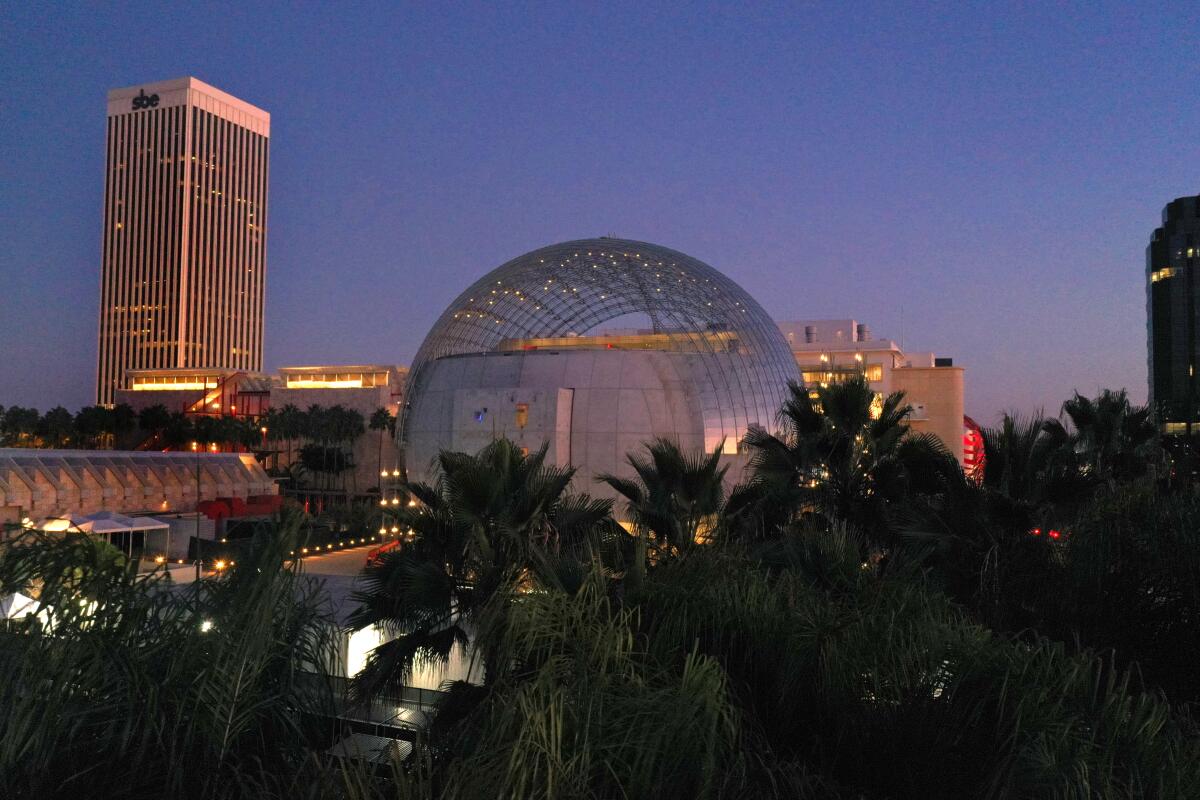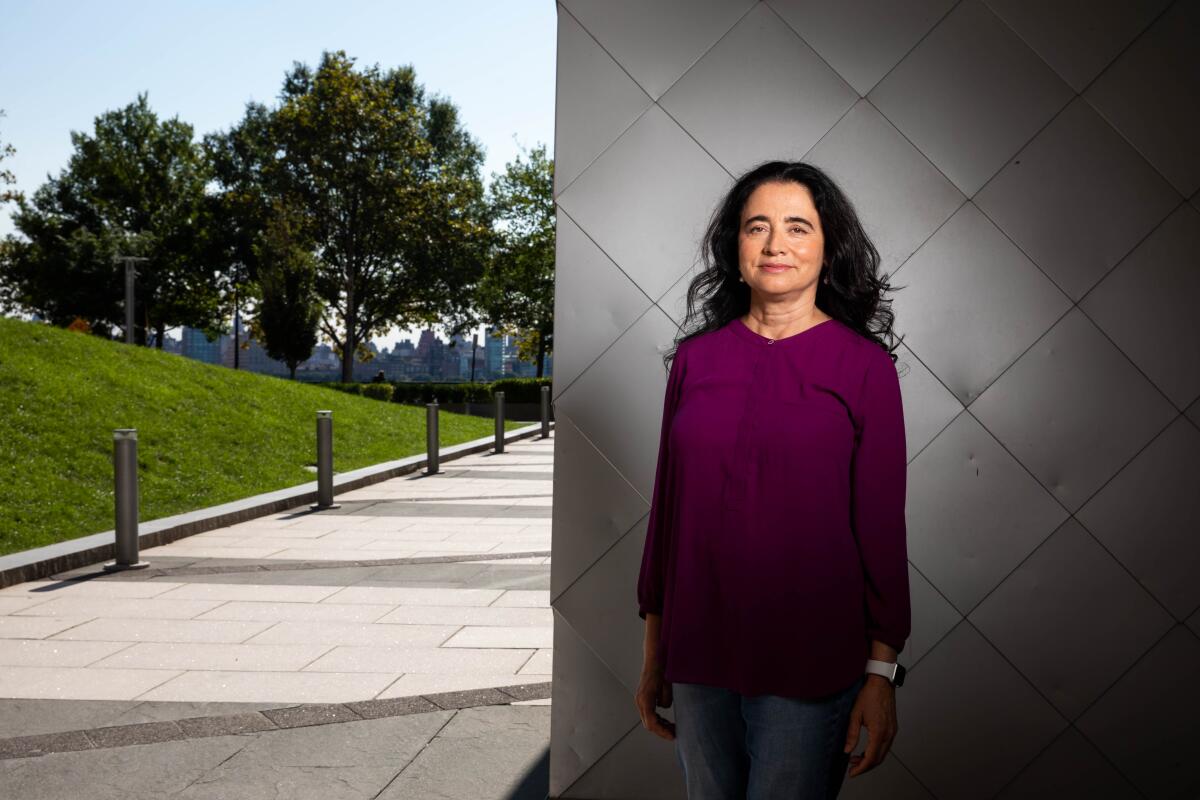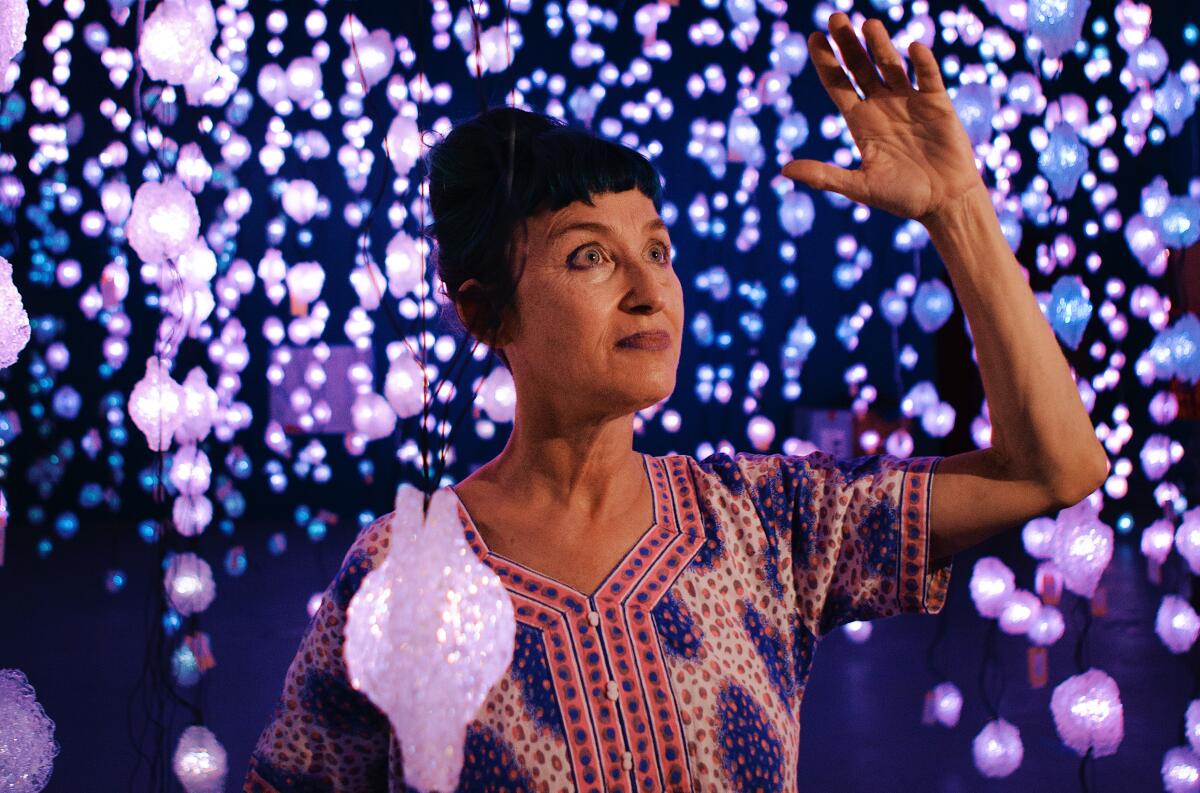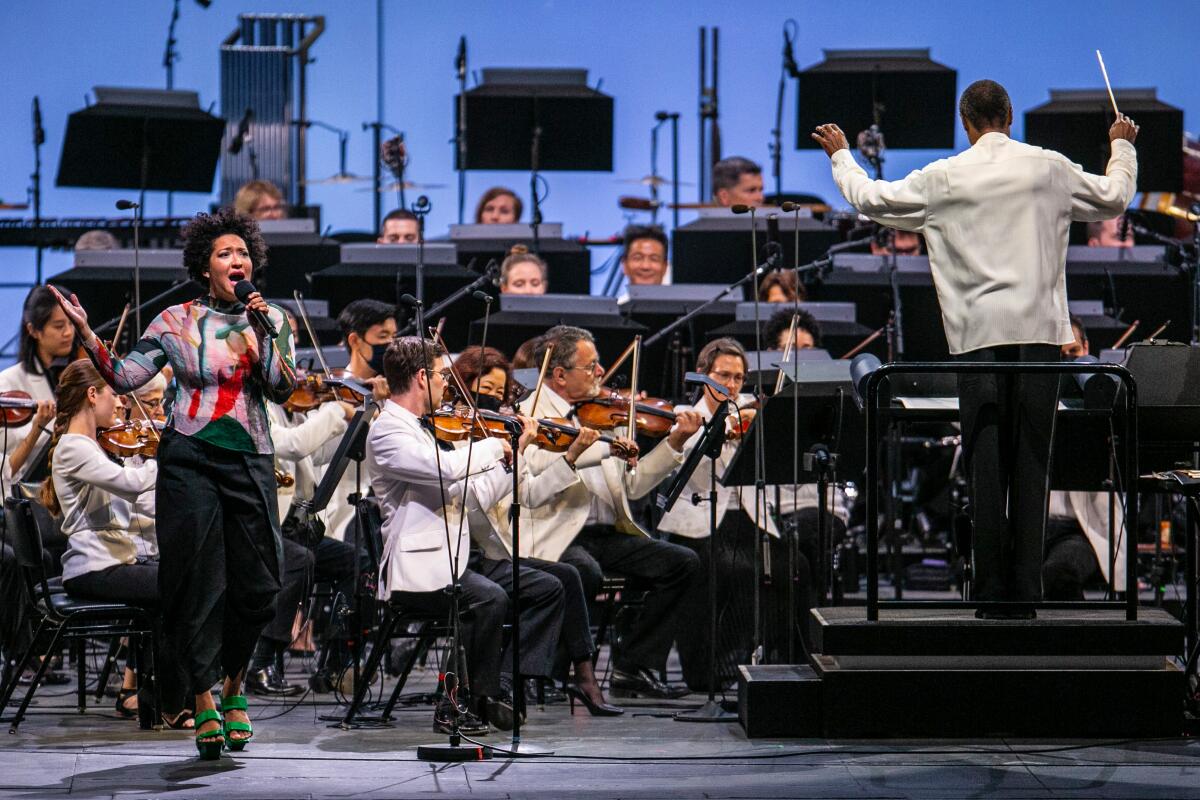Newsletter: The Academy Museum is almost fully operational

- Share via
As the third-oldest Taco Bell in the world closes, a new museum rises — and, thus, the circle of life is complete. I’m Carolina A. Miranda, arts and urban design columnist for the Los Angeles Times, with the week’s essential culture news — and moody techno drops:
That’s no moon
After a long — very long — wait, the Academy Museum of Motion Pictures is finally set to open at the end of the month. And The Times is ready with a guide to everything you need to know about the place.

Culture columnist Mary McNamara is ready to welcome the new museum, which has spent “more time in development hell than any other project in Hollywood,” she writes. The delays, she notes, were worth it, since the museum is now able to reflect the cultural shifts of the last four years, such as the #MeToo movement and the overhaul of an Academy of Motion Picture Arts and Sciences membership that was once 94% white and 77% male.
Jacqueline Stewart, the museum’s chief artistic and programming officer, tells Times film reporter Mark Olsen that this will be a museum that aims to tell the stories (plural) of film. “There is no the history of cinema,” she says. “And even if we could claim that there was a history of cinema ... 10 years from now we would see it totally differently.”
Make the most of L.A.
Get our guide to events and happenings in the SoCal arts scene. In your inbox every Monday and Friday morning.
You may occasionally receive promotional content from the Los Angeles Times.
Hollywood has historically ignored women, but the new museum does not. In fact, most of the 13-person curatorial team are women, reports Jessica Gelt, “raising interesting possibilities when those women are tasked with highlighting accomplishments in an industry with such a long record of sexism and discrimination.” In a separate piece, Gelt takes a look at how the museum belatedly honors one female director: Patricia Cardoso, who helmed the critically acclaimed “Real Women Have Curves.” Her film, based on playwright and Casa 0101 founder Josefina López’s script — is given equal billing with “Citizen Kane” in the Significant Movies and Movie Makers gallery. But until recently she was unable to find film work in Hollywood despite the 2002 movie’s success.

Art critic Christopher Knight writes that the ambitious transformation of the May Co. building into the Academy Museum is both “impressive” and “demoralizing.” Impressive for its adaptive reuse of the 1939 department store, which had languished for years. “Dispiriting, on the other hand, is the project’s confirmation that its next-door neighbor, the Los Angeles County Museum of Art, made a terrible mistake in giving up the building.”
Soundtracks are a key part of filmmaking — who hasn’t sung the theme from “Jaws” at one time or another? — but classical music critic Mark Swed reports that music gets short shrift in the new Academy Museum. “Devoting an entire museum to the émigré composers who came to L.A. in the 1930s to escape Nazi persecution, just as talkies were taking off, is not out of the question,” he writes. “They invented the symphonic score.”
The museum, however, does feature animation: One of its most anticipated inaugural exhibits will be devoted to the work of venerable animator Hayao Miyazaki, the creator of wondrous films such as “My Neighbor Totoro” and “Princess Mononoke.” The Times’ Tracy Brown got a look behind the curtain and found some magical installations inspired by Miyazaki’s interest in nature.
And what would the Academy Museum be without an Oscar ceremony? Times game critic Todd Martens receives his golden statuette to a round of piped-in applause when he tries out the museum’s Oscars Experience but is played off the fantasy stage before he can thank the academy. He says to expect similar theme park-like attractions in future museums.
The Times’ Deborah Vankin reports on all the little details that make the Academy Museum stand out — starting with the seats. Because this is an institution that takes Hollywood butts very seriously, there was a two-year process to find the perfect seat for the museum’s two theaters. She also dives in the building’s engineering: namely, the exposed base isolators that will support the Geffen in the event of an earthquake. (Who will be the first director to creatively destroy this theater in a film? Michael Bay? Anyone?) And how does one keep an 11-story-high glass dome clean? It involves suspension ropes and nerves of steel. Also, a hawk. Very practical.
And me? I’ve been to the museum in search of Marlon Brando’s Oscar and the Werner Herzog Dyspepsia Immersion Chamber but have yet to locate them. I’ll be back soon, however, with an architectural review written entirely in movie trailer voice: This summer ... one man ... will build ... the largest ball ... in Los Angeles.
In the meantime, check out The Times’ comprehensive guide to the Academy Museum — with reports on its most iconic objects, the splashy in-house restaurant and the ghost. OK, maybe there’s a ghost. Or maybe I desperately want there to be a ghost.
Remembering 9/11
Twenty years have passed since a pair of airliners streaked across the New York sky and into the World Trade Center. It is an anniversary rendered infinitely more poignant by the United States’ recent withdrawal from Afghanistan, a war that began as a result of the attack. Times political reporters Melanie Mason and Janet Hook look at how the event shaped a generation of U.S. political leaders, Meena Venkataramanan reports on how it also shaped its activists, and Brittny Mejia examines how it changed life for Muslim youth in the U.S.
Plus, in a very personal reminiscence, Benjamin Oreskes looked at how the event shaped a generation of millennials. Oreskes’ mom, Geraldine Baum, helped cover the attack for The Times in 2001.

9/11, of course, also shaped culture — and remade New York’s financial district. Curbed architecture critic Justin Davidson has a great essay on the paranoiac ways in which 9/11 influenced architecture. “This is a landscape of fear,” he writes. “It has been formed not only by the reasoned response to a documented threat but by an amorphous, open-ended anxiety.”
Alexandra Lange of Bloomberg Citylab, has an insightful piece on architect Minoru Yamasaki’s design for the World Trade Center. The Japanese American architect contended with racism and derision throughout his career and his Twin Towers went unloved by critics such as Ada Louise Huxtable. Lange says it’s time for a major reappraisal: “The Twin Towers were bold. The first cut on skyscrapers is to treat them as sculpture, and as sculpture the towers more than succeeded.”
Mark Lamster of the Dallas Morning News says of them: “They almost defied criticism. They had a looming magnetic energy that was so transfixing as to achieve the sublime.”

Architectural Digest has an interview with Michael Arad, who designed the 9/11 Memorial — a pair of pools that echo the footprints of the Twin Towers. The architect says that with the passage of time, he has been able to set aside the memories of the struggles it took to get the memorial built, and appreciate it more on an emotional level. “With time, you get a different perspective.”
And as people remember the hijacked United Flight 93, which passengers and crew members brought down before it could get to Washington, D.C., it’s a good time to reread my interview with Paul Murdoch, lead designer of the Flight 93 Memorial. The Western Pennsylvania site was finished in 2015, but just last year added “The Tower of Voices,” which functions as a massive wind chime. “By using the wind,” Murdoch said, “it’d be an ever-changing memorial expression.”
New York Times critic at large Jason Farago meditates on the ways in which artists, writers and filmmakers grappled clumsily with 9/11, while finding surer footing in facing the Iraq war. “On our screens as in our lives, Sept. 11 had become the undercard for Iraq,” he writes, “in that, at least, the administration succeeded.”
Enjoying this newsletter? Consider subscribing to the Los Angeles Times
Your support helps us deliver the news that matters most. Become a subscriber.
The New York Times also has a look back at the star-filled ad that helped draw audiences back to Broadway after 9/11.
L.A. Times theater critic Charles McNulty considers the surprisingly enduring appeal of “Come From Away,” a “lovably hokey” musical that tells an inspiring tale about passengers stranded in a Newfoundland town after flights were grounded on 9/11. It is about the “selflessness of ordinary men and women, who rather than resenting the encroachment on their provincial peace embraced their role as global citizens with majestic humility,” he writes.
Also, Times TV critic Lorraine Ali had a great essay recently about how remembrances of 9/11 in the U.S. have failed to capture the human toll of its subsequent wars. “It’s hard to get behind the media’s ongoing canonization of the attacks,” she writes, “after two failed wars, thousands of lives lost and millions of people displaced, including my extended Iraqi family.”
And Times books editor Boris Kachka felt enough time had passed to ask culture writer Chris Vognar to assess the most memorable 9/11 novels and choose the best of them.
Art report
Because MOCA can’t seem to stay out of the headlines, it was announced in the Art Newspaper on Friday morning that director Klaus Biesenbach will be leaving the museum to head up Berlin’s Neue Nationalgalerie. As the Times’ Jessica Gelt reports, the move comes just eight days after Johanna Burton was named co-director, with Biesenbach, of the museum — a move overshadowed by the museum’s ham-handed public relations tactics. What this means for the idea of co-directors at MOCA is now up in the air.
Thankfully, there is some good news coming out of MOCA — and it’s thanks to the affable Swiss artist Pipilotti Rist, who has taken over MOCA Geffen for a show that swallows the place whole. I got a sneak peek and it is mind-boggling: The warehouse is now a sumptuous garden and its walls, its windows and its floors, a place onto which Rist projects videos that meld body and landscape. As MOCA curator Anna Katz predicts, this will be one show that will function as “a bit of a tonic.”

The Huntington Library has announced that it has commissioned Kehinde Wiley to create a response to one of the most iconic works in its collection: Thomas Gainsborough’s 1770 canvas “The Blue Boy.” It’s a return to an institution that bears emotional resonance for the artist, who is from L.A. “Looking at those paintings gave me a sense of joy and wonder,” he tells Deborah Vankin, of going to the museum as a young man. “But there was also a disconnect — the life I was having in South-Central Los Angeles and then these incredibly mannered and organized gardens and these portraits that hung on the walls.”
Erika Rothenberg’s 2001 art work, “The Road to Hollywood,” a series of mosaics embedded into the outdoor plaza and walkways at the Hollywood & Highland complex is going under the jackhammer. The piece is being lost to a renovation. Rothenberg has been trying to find funding to remove and store the work but has been unable in the tight timeline allotted by the developer. “I don’t discount the idea that nothing lasts forever,” she tells contributor Catherine Womack, “but it is heartbreaking.”
Performance notes
Classical music critic Mark Swed found overlap in a pair of very different, but very resonant performances this past week. One featured Julia Bullock performing music by Gershwin and three Black composers with the L.A. Phil at the Hollywood Bowl. The other consisted of bass-baritone Davóne Tines performing a 1925 song by Margaret Bonds and “Recital No. 1: MASS” at the First Congregational Church. Reports Swed: “It has been increasingly evident that Bullock and Tines are the two singers who can most promisingly bring something powerful, meaningful and even existential to opera.”

Essential happenings
There is too much going on! And Matt Cooper comes through with some of the best, including a new show by the Troubadour Theater Company that fuses “Lysistra” and Liza Minnelli and a concert by Michael Feinstein and the Pasadena Pops that celebrates Broadway at the L.A. County Arboretum.
If you’re feeling the Hollywood Bowl vibes, the L.A. Phil will be performing a live score for a screening of “Black Panther” on Saturday night. Contributor Tim Greiving reports on all that it will take to bring Ludwig Göransson’s dynamic score — which blends electronic and symphonic elements with Senegalese sounds — to life.

Passages
Yolanda López, an artist known for her feminist subversions of imagery of the Virgin of Guadalupe, has died at 79. The artist will be the subject of a solo show opening at the Museum of Contemporary Art San Diego next month.
In other news
— After 131 years, the statue of Robert E. Lee in Richmond, Va., has, at long last, been removed.
— Mexico City will replace a statue of Christopher Columbus with a monument to Indigenous women by artist Pedro Reyes.
— Long buried in paint, a cupid emerges in a famous canvas by Johannes Vermeer.
— The planet is on fire, and we really need to cut all global emissions yesterday, but don’t worry, you guys, in-person art fairs are back.
— “Usually things were bad; sometimes, they were worse.” An absolutely blazing piece by Dana Kopel on the state of art and labor at New York’s New Museum.
— Catherine Wagley has a really interesting essay in CARLA that examines the ways in which community art and the art community do and don’t intersect.
— The same issue of CARLA (a really great one) also has a good Q&A with CAAM curator Taylor Renee Aldridge by Eva Recinos.
— Really dug this Ligaya Mishan essay about fakes and cakes.
— So apparently it would have been a bad idea to have Mies van der Rohe design LACMA.
— The City of Long Beach moves forward on the creation of a Cambodian American Cultural Center.
— The foil wrapped home that survived the Caldor fire.
— Expanding freeways just expands the inequities that were built into them in the first palace: In South Carolina, the expansion of the I-526 and I-26 interchange is going displace hundreds of people, 94% of them Black and brown.
And last but not least ...
My current mood is Lil’ Arturo’s “I Make Friends on the Internet.”
The biggest entertainment stories
Get our big stories about Hollywood, film, television, music, arts, culture and more right in your inbox as soon as they publish.
You may occasionally receive promotional content from the Los Angeles Times.




